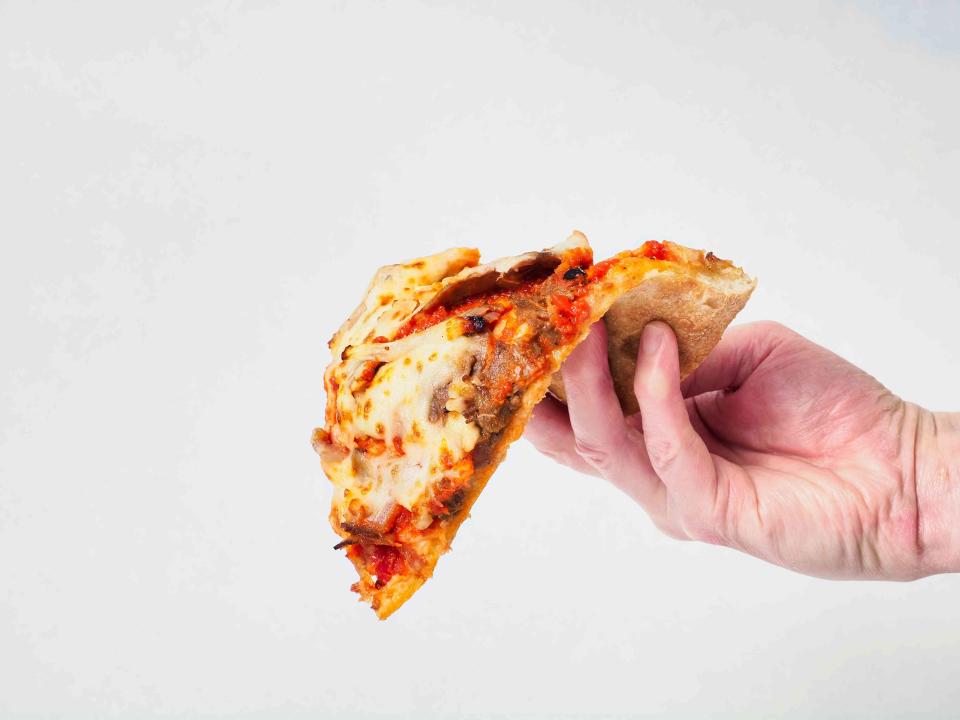Why Do We Still Believe This Food "Rule" from Childhood?
And is there any truth to it at all?

A hand holding a overloaded slice of pizza folded over and about to fall on the floor.
If you ever dropped a piece of food onto the floor, you might have quickly picked it up and continued eating it without hesitation. Because everyone knows the "Five-Second Rule," right?! If you somehow missed what that is, it's an old adage suggesting that any food dropped on the floor is still safe to eat if you pick it up within five seconds. So, what is the five-second rule and is there any merit to it? And how has it become so engrained in our habits? We spoke with food safety experts to weigh in on the rule.
Where Did the Five-Second Rule Come From?
The five-second rule refers to eating food dropped on the floor after quickly picking it back up. However, Kristen Nauss, MS, MBA, RD, SNS, registered dietitian and founder of Buying School Food, says this "rule" is actually an old myth.
Nauss explains that the idea behind the five-second rule is generally believed to have started by Genghis Khan, the founder and ruler of the Mongolian Empire in the thirteen century. At the time, if food dropped in his banquet hall, he would decide whether the food could be eaten.
As time passed, Khan's rule became a common household practice. When ready-to-eat foods are dropped onto the floor for five seconds (or less), the assumption is that time is too short for the food to become contaminated by microorganisms, thus making it safe to eat.
The Science Behind the Five-Second Rule
In reality, though, it can take less than five seconds to contaminate the dropped food with harmful bacteria, such as Salmonella or E.coli, according to Lisa Yakas, Senior Account Manager, Product Certification, Global Food Division of NSF.
Several research studies have debunked the five-second rule, including a 2021 study from the Journal of Food Protection. That study found that bacteria from the grocery store floor was instantly transferred to the produce when the produce items dropped onto the floor. Yes, instantly.
The floors of public spaces are certainly riskier, but that does not mean the floors of your home are germ-free either. Just because your kitchen floor is spotless, bacteria and other pathogens could still be present that cannot be seen by the naked eye.
Yakas adds, "No matter where you are, the floor can contain bacteria that can come into contact with the food and potentially make you sick."
The longer the food comes in contact with the floor, the more bacteria is transferred to the item. A research study from 2016 also noted that more germs are transferred from the floor to the food if the food is moisture-rich, like watermelon or cucumber.
Nonetheless, the risk of getting sick from eating ready-to-eat foods that come in contact with the floor, regardless of the length of time, remains the same. This risk is especially true for children, older adults, and people with underlying health conditions or weakened immune systems.
What To Do With Dropped Food
Use your best judgement! If the dropped food has a skin you can peel or wash off, it may still be safe to eat. Otherwise, unless you plan to cook the dropped food before serving it (so that heat can kill off the disease-causing bacteria), that food is likely deemed unsafe to eat regardless of how long it has touched the ground. Yakas says, "Your best bet would be simply throwing out the food." Sad to say, but this childhood myth has about as much truth behind it as the tooth fairy.

